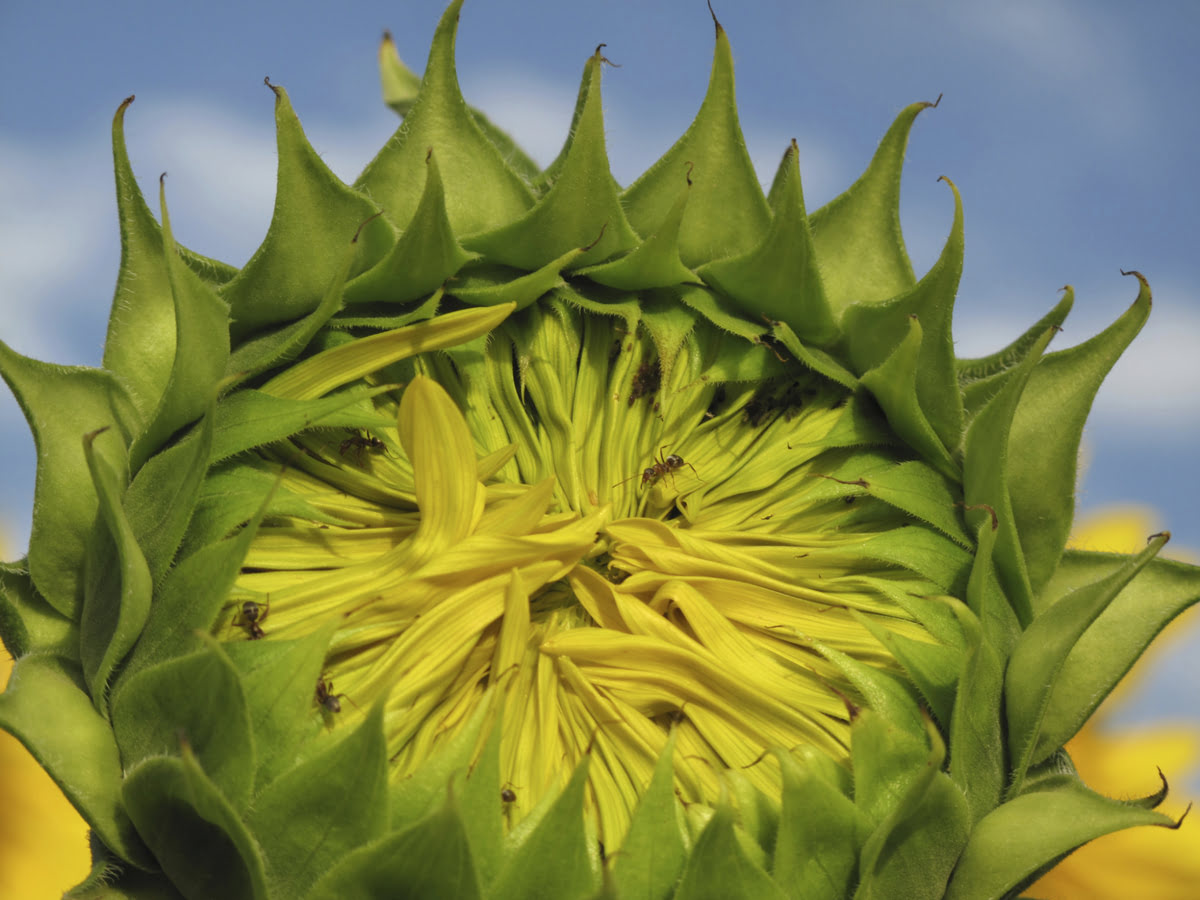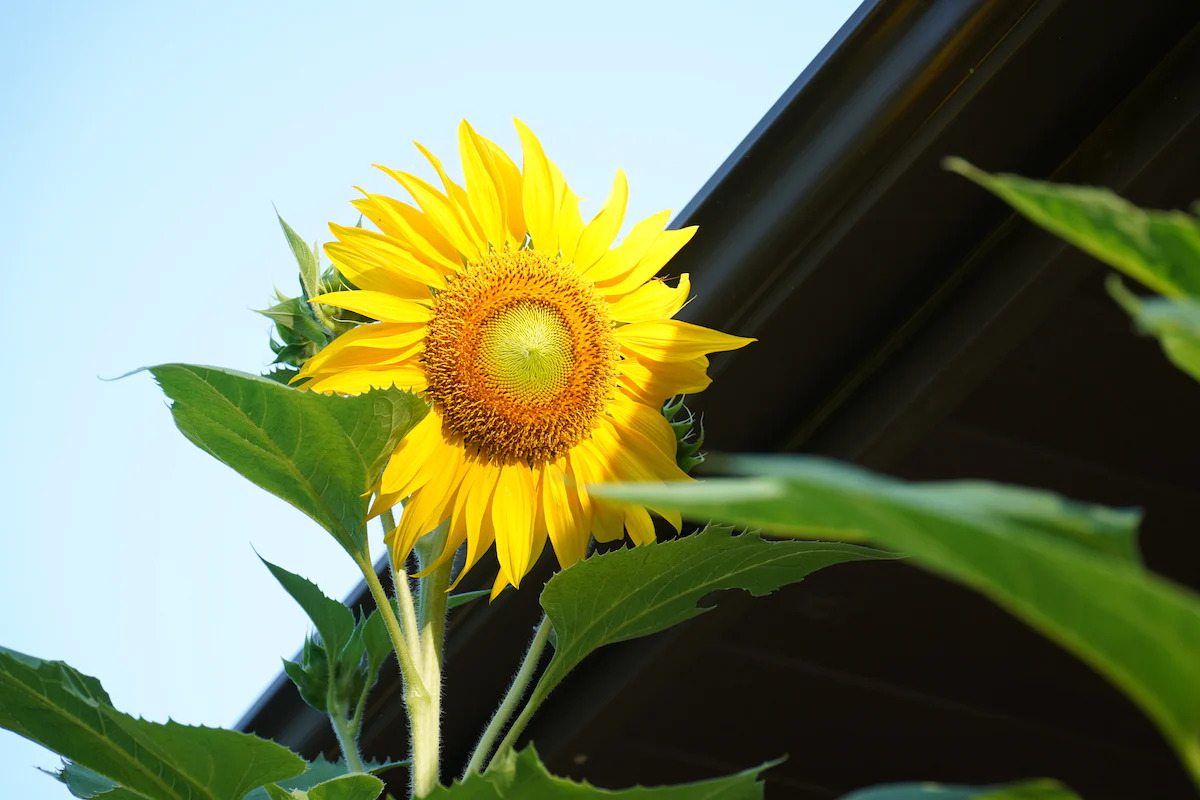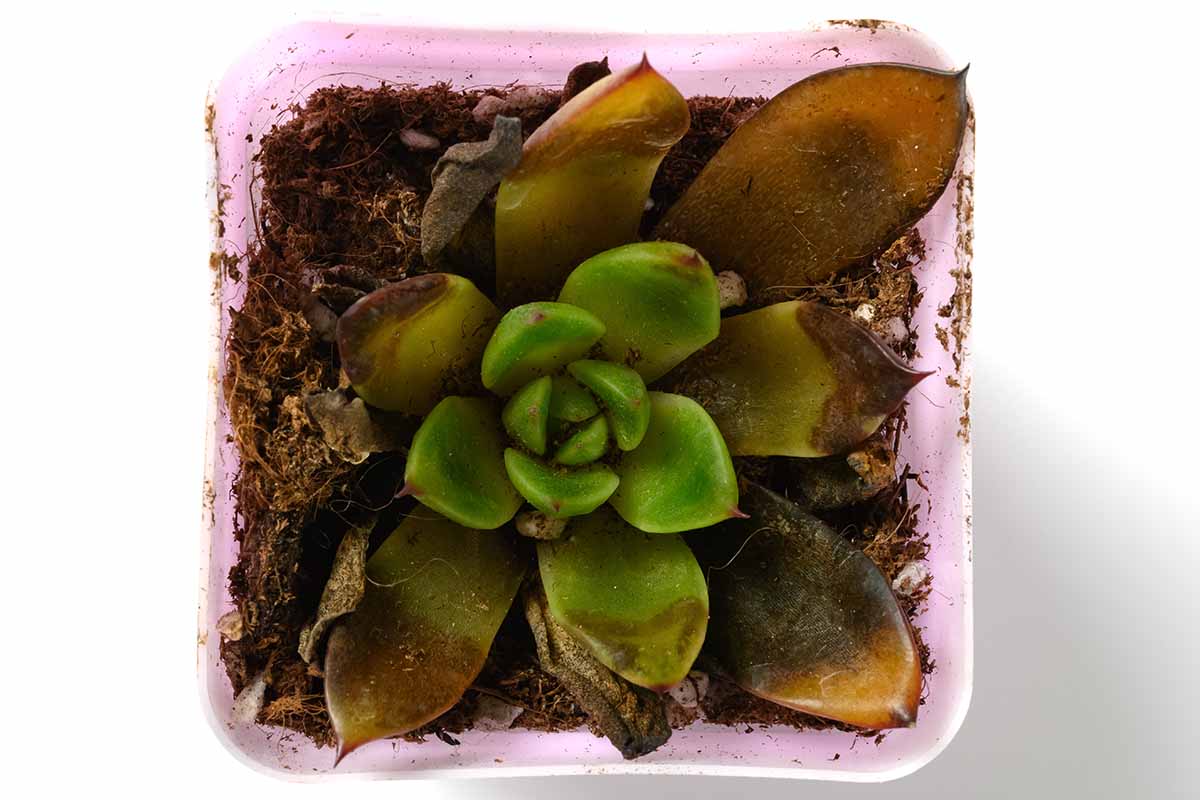Home>Types of Gardening>Ornamental Gardening>Why Do Sunflowers Follow The Sun


Ornamental Gardening
Why Do Sunflowers Follow The Sun
Modified: January 22, 2024
Discover the fascinating phenomenon of sunflowers following the sun and learn how you can incorporate this delightful feature into your ornamental gardening.
(Many of the links in this article redirect to a specific reviewed product. Your purchase of these products through affiliate links helps to generate commission for Chicagolandgardening.com, at no extra cost. Learn more)
Table of Contents
- Introduction
- The Science behind Sunflower Movement
- Phototropism: The Sunflower’s Natural Response
- Understanding Phototropism
- How Do Sunflowers Track the Sun?
- The Role of Circadian Rhythms in Sunflower Sun Tracking
- The Importance of Sunflower Sun Tracking
- Environmental and Ecological Factors Affecting Sunflower Sun Tracking
- Benefits and Advantages of Sunflower Sun Tracking
- Sunflowers: A Symbol of Resilience and Adaptation
- Conclusion
Introduction
Welcome to the intriguing world of sunflowers, where the beauty of nature meets the science behind plant behavior. Have you ever wondered why sunflowers seem to follow the sun as it travels across the sky? This mesmerizing phenomenon has captured the curiosity and imagination of people for centuries.
In this article, we will delve into the fascinating topic of sunflower sun tracking. We will explore the scientific principles behind this movement, discuss the role of phototropism, and uncover the reasons why sunflowers exhibit this behavior. So, let’s embark on this journey to understand why sunflowers follow the sun!
The sight of a field of sunflowers, their vibrant yellow petals stretching towards the sun, is a true spectacle of nature’s beauty. But what drives this mesmerizing movement? Is it solely for aesthetic purposes, or does it serve a functional role in the life of a sunflower?
To unravel the mystery of sunflower sun tracking, we need to explore the science behind it. The concept of phototropism holds the key to understanding this natural phenomenon. Phototropism refers to the ability of plants to orient their growth towards a light source, which in the case of sunflowers, is the sun.
As we delve deeper into the world of sunflowers, we will discover that sunflower sun tracking is not just a random display of movement. It is a well-coordinated response orchestrated by nature. Sunflowers possess an inherent biological mechanism that allows them to adjust their position to optimize their exposure to sunlight throughout the day.
But why is it so important for sunflowers to follow the sun? What benefits does this behavior provide? We will explore these questions in detail, taking into consideration the environmental and ecological factors that influence sunflower sun tracking.
As we delve into the world of sunflowers, we will come to appreciate their resilience and adaptability. Sunflowers have long been regarded as a symbol of vitality and optimism, and their ability to track the sun is a testament to their ability to thrive in various conditions.
So, join us on this journey to uncover the secrets of sunflower sun tracking and deepen our appreciation for the wonders of the natural world. Let’s dive into the science behind sunflowers and explore the enchanting world of ornamental gardening.
The Science behind Sunflower Movement
Have you ever wondered how sunflowers possess the remarkable ability to track the sun’s movement across the sky? This phenomenon is not merely a coincidence or a whimsical display of nature’s beauty; there is a scientific explanation behind it.
The sunflower’s movement, also known as heliotropism, is a result of a natural response called phototropism. Phototropism is the growth or movement of a plant in response to light. When sunlight hits a sunflower, it triggers a series of biochemical reactions that result in the plant’s stem and leaves bending towards the light source.
But how does this process work? Within the cells of a sunflower’s stem, there are specialized structures called photoreceptors. These photoreceptors are sensitive to light and play a crucial role in regulating the plant’s growth and movement.
When sunlight reaches the photoreceptors, it initiates a chain of chemical reactions that lead to the redistribution of auxin, a plant hormone responsible for promoting growth. The auxin levels in the sunflower’s cells increase on the shaded side, causing the cells to elongate and the stem to bend towards the light, essentially following the path of the sun.
This continual process of phototropism allows sunflowers to adjust their position throughout the day, optimizing their exposure to sunlight. By facing the sun, sunflowers maximize their photosynthetic capabilities, capturing the maximum amount of light needed for energy production.
It is important to note that sunflowers do not actually “chase” the sun in the traditional sense. Rather, they constantly readjust their position in response to changes in the sun’s angle and intensity. This dynamic movement is a result of their growth patterns regulated by phototropic responses.
Sunflowers possess an innate sense of direction, ensuring that they face the east in the morning and continue to follow the sun’s path until it sets in the west. This remarkable ability to track the sun’s movement allows sunflowers to maximize their growth and reproductive success.
Understanding the science behind sunflower movement not only provides us with valuable insights into plant behavior but also deepens our appreciation for the incredible complexity and adaptability of nature. Sunflowers have evolved this mechanism over time to ensure their survival and growth in various environmental conditions.
In the next section, we will dive deeper into the intriguing concept of phototropism, uncovering the factors that influence sunflower’s sun tracking behavior.
Phototropism: The Sunflower’s Natural Response
Phototropism is a critical biological phenomenon that allows plants, including sunflowers, to respond and adapt to changes in light conditions. It is the underlying mechanism behind the sunflower’s remarkable ability to track the sun’s movement throughout the day.
Phototropism is a combination of two Greek words: “photo,” meaning light, and “tropism,” referring to a plant’s directional growth response to external stimuli. It is regulated by the plant hormone auxin, which plays a crucial role in controlling the growth and development of plants.
When sunlight hits a sunflower, the photoreceptors, called phototropins, located in the plant’s stem and leaves, detect the light. These photoreceptors are sensitive to the blue light spectrum, which is abundant in natural sunlight.
Upon detecting light, the phototropins trigger a signal transduction pathway within the plant’s cells. This pathway leads to the redistribution of auxin, with higher levels accumulating on the shaded side of the sunflower.
The increased concentration of auxin on the shaded side of the stem stimulates cell elongation, causing the stem to bend and the sunflower to reorient itself towards the light source. This phototropic response is essential for the sunflower’s survival, as it allows the plant to maximize its exposure to sunlight, a crucial resource for growth and energy production.
The phototropic response in sunflowers is a highly coordinated process involving the regulation of gene expression, protein synthesis, and cellular growth. It enables the plant to modulate its growth patterns and optimize its photosynthetic capabilities throughout the day.
It is important to note that phototropism is a dynamic response. As the sun moves across the sky, the intensity and direction of sunlight change. Sunflowers continuously monitor these changes and adjust their growth patterns accordingly, ensuring that they are always facing the sun.
In addition to the sunflower’s stem, the leaves also exhibit phototropic responses. This allows the plant to maximize the surface area exposed to sunlight, enhancing its photosynthetic efficiency.
While phototropism is vital for the sunflower’s growth and survival, it is not the only environmental factor that influences its movement. Sunflowers also demonstrate other forms of tropism, such as gravitropism, which is the plant’s response to gravity, and thigmotropism, which is their response to touch.
Understanding phototropism provides fascinating insights into the complex interactions between plants and their environment. It is a testament to the remarkable adaptability and resilience of sunflowers, allowing them to thrive in diverse ecological settings.
Now that we have explored the concept of phototropism, let’s dive deeper into how sunflowers track the sun and the role of circadian rhythms in this process.
Understanding Phototropism
Phototropism is a fascinating biological phenomenon that enables plants, including sunflowers, to respond to light and adjust their growth patterns accordingly. By understanding the mechanisms behind phototropism, we can gain deeper insights into the intricate ways in which plants interact with their environment.
At the core of phototropism is the plant hormone auxin. Auxin acts as a key regulator in controlling plant growth and development. When sunlight reaches a sunflower, it initiates a cascade of biochemical reactions that lead to the redistribution of auxin within the plant’s cells.
The distribution of auxin in response to light is mediated by a class of proteins called PIN proteins. These proteins are responsible for transporting auxin from one part of the plant to another. In sunflowers, these PIN proteins are particularly abundant in the stem and leaves where they facilitate the movement of auxin.
When light hits a sunflower, the photoreceptors in the plant’s cells detect it and signal for auxin to be transported towards the shaded side of the stem. This differential distribution of auxin causes the cells on the shaded side to elongate, resulting in the bending of the stem towards the light source.
The movement of auxin is not limited to the stem alone. It also influences the growth and movement of other parts of the sunflower, such as the leaves. As auxin accumulates on the shaded side of the plant, it promotes cell elongation and expansion, causing the leaves to reorient towards the light.
While the exact molecular mechanisms that govern phototropism are still being studied, researchers have made significant progress in uncovering the intricate signaling pathways involved. They have identified several key proteins and genes that play a crucial role in mediating phototropic responses.
One such protein is phototropin, which serves as the primary photoreceptor responsible for detecting light in plants. Phototropins are activated by specific wavelengths of light, particularly blue light, triggering a series of events that ultimately lead to the redistribution of auxin.
In addition to auxin and phototropins, other signaling molecules and proteins work in concert to regulate phototropic responses. These include factors involved in cell expansion, cytoskeleton reorganization, and changes in gene expression.
It is important to note that phototropism is not limited to sunflowers alone; many other plants exhibit this behavior as well. However, the degree of phototropic movement can vary across different species and under different environmental conditions.
Understanding the mechanics of phototropism provides us with invaluable insights into how plants perceive and respond to their surroundings. It reveals the intricate ways in which plants can adapt their growth patterns to optimize their exposure to sunlight, a vital resource for energy production and survival.
Now that we have a solid grasp of phototropism, let’s explore how sunflowers specifically track the sun and the role of circadian rhythms in this process.
How Do Sunflowers Track the Sun?
The remarkable ability of sunflowers to track the sun’s movement is a result of a combination of factors, including phototropism, circadian rhythms, and environmental cues. Together, these elements enable sunflowers to maintain an optimal position relative to the sun throughout the day.
As we have already discussed, phototropism plays a central role in sunflower sun tracking. The photoreceptors within the sunflower’s stem and leaves detect the direction and intensity of sunlight, initiating a response that causes the plant to reorient itself towards the light source.
But how do sunflowers achieve such precise movements to track the sun as it moves across the sky? The answer lies in the interaction between phototropism and circadian rhythms.
Circadian rhythms are internal biological clocks that regulate an organism’s physiological and behavioral processes over a 24-hour period. Sunflowers, like many other plants, possess circadian rhythms that dictate various aspects of their growth and development.
The circadian clock in sunflowers entrains the plant’s internal processes and aligns them with the external environment, allowing the plant to anticipate and respond to daily changes, such as the movement of the sun.
Studies have shown that the circadian clock in sunflowers influences the expression of specific genes that are involved in regulating the plant’s response to light. These genes help coordinate the plant’s growth and movement patterns in relation to the sun.
During the day, when sunlight is abundant, the circadian clock promotes the elongation of cells on the shaded side of the stem, initiating the bending of the stem towards the light. This growth response is a combination of phototropism and the circadian clock working together.
As the sun moves across the sky, the circadian clock continues to drive the plant’s growth and movement, ensuring that the sunflower remains aligned with the sun’s path. This coordination between phototropism and the circadian clock allows sunflowers to continuously adjust their position throughout the day.
In addition to phototropism and circadian rhythms, sunflowers also rely on other environmental cues to fine-tune their sun tracking abilities. Factors such as temperature, humidity, and the presence of neighboring plants can influence the extent and direction of sunflower sun tracking.
For example, sunflowers growing in dense fields may exhibit less pronounced sun tracking compared to those growing in more open spaces. This is because the neighboring plants can provide shade and alter the distribution of light, affecting the sunflower’s phototropic response.
By integrating information from their photoreceptors, circadian clock, and environmental cues, sunflowers can orchestrate their growth and movement to maximize their exposure to sunlight. This optimization is crucial for their photosynthetic efficiency, as it allows them to capture the maximum amount of light needed for energy production and growth.
Understanding how sunflowers track the sun provides us with a glimpse into the intricate mechanisms that plants employ to navigate their environment. It highlights the remarkable adaptability and sophistication of nature’s designs, inspiring awe and appreciation for the wonders of the plant world.
Next, let’s explore the importance of sunflower sun tracking and the benefits it provides to these magnificent plants.
The Role of Circadian Rhythms in Sunflower Sun Tracking
Circadian rhythms play a crucial role in sunflower sun tracking, helping to coordinate and regulate the plant’s movement in response to the daily changes in light and darkness. These internal biological clocks allow sunflowers to anticipate and adapt to the sun’s movement, maximizing their exposure to sunlight, and optimizing their growth and development.
Sunflowers, like many other organisms, possess an internal circadian clock that follows a roughly 24-hour cycle. This internal clock is entrained by external cues, primarily light and darkness, and it controls various biological processes within the plant.
At the core of the circadian clock are a series of interconnected molecular mechanisms that control the expression of specific genes at different times of the day. These gene expression patterns, in turn, modulate the plant’s physiological and metabolic activities, including growth and movement.
In sunflowers, the circadian clock influences the expression of genes involved in phototropism, the process that allows plants to respond to light by adjusting their growth direction. The circadian clock synchronizes with the external light-dark cycle, ensuring that the sunflower’s growth and phototropic responses align with the movement of the sun.
During the day, when sunlight is available, the circadian clock promotes cell elongation on the shaded side of the sunflower’s stem. This elongation occurs in response to the accumulation of the plant hormone auxin, which is regulated by phototropism and the circadian clock.
The coordination between phototropism and the circadian clock allows sunflowers to continuously adjust their growth and movement, ensuring that they remain oriented towards the sun throughout the day. This optimization allows the sunflower to capture the maximum amount of sunlight needed for photosynthesis, a process crucial for their energy production and growth.
The circadian clock also influences other aspects of sunflower physiology, including the opening and closing of the flower, the timing of pollen release and pollination, and the production of certain secondary metabolites. These processes are regulated by the rhythmic expression of specific genes controlled by the circadian clock.
The importance of circadian rhythms in sunflower sun tracking becomes apparent when considering the ecological significance of this behavior. Sunflowers growing in a natural environment face various challenges, such as competition for sunlight, changes in weather conditions, and variations in the sun’s angle throughout the year.
By relying on their circadian rhythms, sunflowers can adjust their growth patterns and movement in response to these challenges. They can optimize their sun tracking behavior to ensure that they receive the maximum amount of light energy needed for growth and reproduction.
The circadian clock also provides sunflowers with the ability to adapt to changes in their environment. For example, if a sunflower is suddenly shaded by a growing neighboring plant, the circadian clock can modulate the plant’s growth and movement to compensate for the reduced sunlight availability.
In summary, the circadian rhythms in sunflowers play a pivotal role in their sun tracking behavior. They synchronize the plant’s growth and movement patterns with the daily light-dark cycle, allowing sunflowers to optimize their exposure to sunlight. By relying on their circadian clock, sunflowers demonstrate their remarkable adaptability and ability to thrive in diverse environmental conditions.
Next, let’s explore the environmental and ecological factors that can influence sunflower sun tracking.
The Importance of Sunflower Sun Tracking
Sunflower sun tracking is not just a fascinating spectacle of nature; it serves a vital purpose for the growth and survival of these radiant plants. The ability to track the sun’s movement has profound implications for the overall health and reproductive success of sunflowers.
One of the primary reasons why sunflowers exhibit this behavior is to maximize their exposure to sunlight. Sunlight is an essential resource for plants as it drives photosynthesis, the process by which plants convert light energy into chemical energy, ultimately fueling their growth and development.
By tracking the sun, sunflowers can maintain an optimal position relative to the sun throughout the day. This allows them to capture the maximum amount of sunlight, ensuring that they can efficiently carry out photosynthesis and generate the energy necessary for their metabolic processes.
Optimizing their sun exposure through sun tracking also enables sunflowers to enhance their nutrient uptake. Through photosynthesis, sunflowers produce carbohydrates and other organic compounds that they can allocate towards nutrient absorption from the soil. This nutrient acquisition further supports their overall growth and vitality.
In addition to maximizing sunlight and nutrient uptake, sunflower sun tracking also plays a role in temperature regulation. By following the sun’s movement, sunflowers can control their exposure to sunlight and adjust their leaf angles, which can help reduce excessive heat absorption during hot periods.
This ability to regulate temperature is especially crucial in arid and high-temperature environments where sunflowers often thrive. By minimizing heat stress, sunflowers can maintain optimal physiological conditions, preventing damage to their cellular structures and preserving their overall health.
Furthermore, sunflower sun tracking has implications for reproductive success. Sunflowers are known for their large, vibrant flowers that attract pollinators, such as bees and butterflies. By facing the sun, these flowers can enhance their visibility and attractiveness to pollinators, increasing the chances of successful pollination and subsequent seed production.
The seeds of sunflowers are rich in nutrients and serve as a valuable food source for many organisms, including birds and mammals. Sunflower sun tracking ensures that the seeds receive adequate sunlight during their development, optimizing their nutritional content and quality. This has ecological implications, as it attracts a wide range of seed-dispersing animals, contributing to the dispersal and propagation of sunflowers across different habitats.
Moreover, sunflower sun tracking contributes to the ecological balance of the surrounding environment. Sunflowers are known to exhibit allelopathic properties, releasing chemicals that can suppress the growth of certain nearby plants. By optimizing their sun exposure, sunflowers can exert greater competitive pressure on surrounding vegetation, potentially promoting biodiversity in their immediate vicinity.
In summary, sunflower sun tracking is of utmost importance to the growth, vitality, and reproductive success of these remarkable plants. It maximizes their exposure to sunlight, enhances nutrient uptake, regulates temperature, attracts pollinators, and contributes to the ecological balance of their surrounding environment.
Now, let’s dive into the environmental and ecological factors that can influence sunflower sun tracking.
Environmental and Ecological Factors Affecting Sunflower Sun Tracking
While sunflowers are known for their remarkable ability to track the sun, their sun tracking behavior can be influenced by various environmental and ecological factors. These factors play a crucial role in shaping the extent and effectiveness of sunflower sun tracking in different habitats and conditions.
One of the primary factors that can affect sunflower sun tracking is the availability and quality of sunlight. Sunflowers thrive in bright, sunny environments, as they require ample sunlight for photosynthesis and growth. In shaded or low-light conditions, sunflowers may exhibit reduced sun tracking or exhibit more conservative growth patterns.
The surrounding vegetation can also impact sunflower sun tracking. In dense forests or crowded fields, neighboring plants can cast shadows and block sunlight, limiting the amount of direct sunlight that reaches the sunflowers. This shade can reduce the intensity of sunflower sun tracking, causing the plants to have less pronounced movements towards the sun.
Furthermore, factors such as temperature and wind can influence sunflower sun tracking. High temperatures can result in excessive transpiration, leading to water stress and reduced growth. In response, sunflowers may adjust their sun tracking behavior to minimize heat absorption and maintain optimal physiological conditions.
Wind can also affect sunflower sun tracking. Strong winds can cause the stems of sunflowers to bend or sway, altering their orientation relative to the sun. In such cases, sunflowers may adopt a more flexible sun tracking strategy to minimize wind-induced damage and maintain their position to capture sunlight.
Interestingly, the age and developmental stage of a sunflower can also impact its sun tracking behavior. Young sunflowers tend to exhibit more pronounced sun tracking as they are actively growing and seeking optimum light conditions. As sunflowers mature and reach their reproductive stage, their sun tracking movements may become less pronounced as their energy is directed towards seed production.
Additionally, genetic factors can influence sunflower sun tracking. Different sunflower varieties may exhibit variations in their sun tracking behavior, with some displaying more vigorous and pronounced movements compared to others. Breeders can select for specific traits related to sun tracking, resulting in sunflower cultivars with enhanced sun tracking abilities.
Ecological factors can also play a role in sunflower sun tracking. For example, pollinators and herbivores can influence the plant’s sun tracking behavior indirectly. Sunflowers may adjust their sun tracking movements to attract pollinators, ensuring successful pollination and seed production. Similarly, herbivores feeding on sunflowers can trigger defense responses that affect their growth patterns and sun tracking behavior.
In summary, a variety of environmental and ecological factors can influence sunflower sun tracking. The availability and quality of sunlight, surrounding vegetation, temperature, wind, developmental stage, genetics, and interactions with other organisms can all shape the extent and effectiveness of sunflower sun tracking in different habitats and conditions.
Next, let’s explore the benefits and advantages of sunflower sun tracking, shedding light on why this behavior is so important for these magnificent plants.
Benefits and Advantages of Sunflower Sun Tracking
Sunflower sun tracking offers a range of benefits and advantages for these magnificent plants. It allows them to optimize their exposure to sunlight, enhance their photosynthetic efficiency, and increase their chances of successful reproduction and ecological interactions.
One of the primary benefits of sunflower sun tracking is the maximization of sunlight capture. By orienting themselves towards the sun throughout the day, sunflowers can ensure that their leaves and flowers receive the maximum amount of sunlight available. This optimal positioning allows them to harness the energy needed for photosynthesis, the process by which they convert light energy into chemical energy.
Enhancing photosynthetic efficiency through sun tracking leads to increased plant growth and development. Sunflowers can allocate more resources towards biomass production, resulting in larger leaves, taller stems, and overall healthier plants. This advantage is particularly important in competitive environments where sunflowers must outgrow neighboring vegetation to access sunlight.
In addition to promoting plant growth, sunflower sun tracking also enhances reproductive success. The sunflower’s vibrant yellow flowers act as beacons for pollinators, attracting bees, butterflies, and other insects that assist in the crucial process of pollination. By tracking the sun, sunflowers increase their visibility to these pollinators, improving the chances of successful pollination and subsequent seed production.
Successful seed production is further enhanced by the optimization of sunlight exposure through sun tracking. Sunflower seeds are nutrient-rich and serve as a valuable food source for birds, mammals, and even humans. By ensuring that their seeds receive adequate sunlight, sunflowers can maximize nutrient accumulation and seed quality, attracting a wide range of seed-dispersing animals and promoting the dispersal and propagation of sunflowers in different habitats.
Another advantage of sunflower sun tracking is in temperature regulation. By actively adjusting their leaf angles and orientation towards the sun, sunflowers can mitigate excessive heat absorption. This ability to regulate temperature reduces heat stress and helps maintain optimal physiological conditions, preventing damage to cellular structures and preserving overall plant health.
Furthermore, sunflower sun tracking contributes to the ecological balance of their surroundings. Through allelopathic properties, sunflowers release chemicals that can suppress the growth of certain neighboring plants. By optimizing their sun exposure, sunflowers can exert greater competitive pressure on surrounding vegetation, potentially promoting biodiversity in their immediate vicinity.
The benefits of sunflower sun tracking extend beyond individual plants and have implications for the overall ecosystem. As sunflowers provide food and habitat for a variety of insects and animals, their optimized sun exposure enhances ecological interactions and supports a diverse community of organisms.
In summary, sunflower sun tracking offers numerous benefits and advantages. It maximizes sunlight capture for efficient photosynthesis, enhances growth and biomass production, improves reproductive success, regulates temperature, contributes to ecological dynamics, and supports a variety of organisms within the ecosystem.
Now that we have explored the benefits of sunflower sun tracking, let’s appreciate the symbolic significance of these beautiful flowers as a symbol of resilience and adaptation.
Sunflowers: A Symbol of Resilience and Adaptation
Sunflowers have long captivated the human imagination with their radiant beauty and remarkable sun tracking behavior. Beyond their physical allure, sunflowers hold a symbolic significance that is rooted in their resilience and adaptation to various environmental conditions.
One of the defining characteristics of sunflowers is their ability to thrive in diverse habitats and climates. From sprawling fields to rugged mountainsides, sunflowers have demonstrated their resilience in adapting to different landscapes. They have evolved to withstand harsh conditions, including extreme temperatures, poor soil quality, and varying levels of sunlight.
The sunflower’s sun tracking behavior serves as a testament to its adaptability. By continuously adjusting their growth and movement patterns to face the sun, sunflowers maximize their exposure to sunlight and optimize their photosynthetic efficiency. This flexible response to changing environmental conditions highlights their ability to adapt and thrive in different ecological settings.
Moreover, sunflowers possess a unique ability to absorb and accumulate heavy metals from the soil, making them useful in phytoremediation processes. They can survive and even flourish in contaminated soils, aiding in the purification of the environment. This resilience and capacity to positively impact their surroundings further solidify their symbolic representation of adaptation and resilience.
In addition to their adaptive qualities, sunflowers also carry a symbolic significance of optimism and vitality. Their bright yellow petals and prominent position in fields create a visual spectacle that uplifts the human spirit. Sunflowers are often associated with joy, happiness, and a positive outlook on life.
Furthermore, sunflowers have played a significant cultural role in various societies throughout history. They have been depicted in art, literature, and folklore, symbolizing resilience, longevity, and the relentless pursuit of light and growth. Sunflowers have been used as motifs in ancient indigenous ceremonies, religious rituals, and celebrations, signifying the renewal of life and the cycles of the natural world.
Today, sunflowers continue to inspire and captivate people from all walks of life. They represent the indomitable spirit that can rise above hardships and adversities. In a world that is constantly changing, sunflowers remind us of the importance of adaptation, resilience, and embracing the beauty and opportunities that come with change.
In our own lives, we can draw inspiration from sunflowers. We can learn to adapt to new circumstances, face challenges head-on, and find strength and beauty in our own unique ways. The sunflower’s ability to track the sun serves as a metaphor for our own pursuit of personal growth, ensuring that we are always facing towards the light, seeking new experiences, and striving to fulfill our potential.
Above all, sunflowers serve as a reminder that even amidst adversity, there is beauty, resilience, and the potential for growth. They symbolize the remarkable capacity of nature and the human spirit to adapt, thrive, and embody the inherent beauty of life.
As we gaze upon the uplifting presence of sunflowers, let us be reminded of our own resilience and the infinite possibilities that lie within us.
Conclusion
The world of sunflowers is truly captivating, from their mesmerizing sun tracking ability to their symbolic representation of resilience and adaptation. Sunflowers have demonstrated their remarkable ability to navigate their environment, optimize their exposure to sunlight, and flourish in diverse habitats.
Through phototropism, sunflowers can actively adjust their growth and movement to maximize their access to sunlight, ensuring efficient photosynthesis and energy production. The coordination between phototropism and the internal circadian clock allows sunflowers to track the sun’s movement and adjust their position throughout the day.
Sunflower sun tracking offers a range of benefits, including enhanced photosynthetic efficiency, increased growth and biomass production, improved reproductive success through pollination, temperature regulation, and ecological interactions. Sunflowers serve as a symbol of resilience and adaptation, reminding us of the beauty and strength that can arise from challenging situations.
Environmental and ecological factors can influence sunflower sun tracking, such as the availability and quality of sunlight, surrounding vegetation, temperature, wind, developmental stage, genetics, and interactions with other organisms. By understanding these factors, we gain a deeper appreciation for the complexity and adaptability of sunflowers.
Sunflowers embody the remarkable resilience and vitality of the natural world. Their ability to adapt and thrive in different circumstances serves as a powerful reminder of the human capacity to overcome challenges and embrace change. The symbolic significance of sunflowers further highlights their ability to inspire joy, optimism, and a positive outlook on life.
As we admire the beauty of sunflowers, let us be inspired by their ability to track the sun, to face the light, and to find strength and grace in the ever-changing world around us. May sunflowers serve as a reminder that we too have the resilience and adaptability to bloom and flourish, no matter the circumstances.
So, as we venture forth in the world of ornamental gardening, let us carry with us the lessons and inspiration we have gained from sunflowers, appreciating the wonders of nature and the remarkable abilities of plants to thrive and adapt. Let us nurture our own resilience and strive to face the challenges of life with optimism, just as the sunflower turns its face towards the sun.










